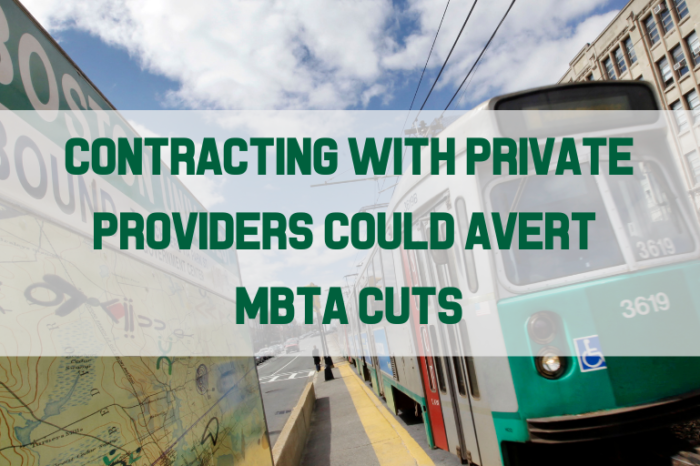Contracting with private providers could avert MBTA cuts
This op-ed originally appeared in CommonWealth Magazine.
In response to a collapse in MBTA service in the winter of 2015, the newly formed Fiscal and Management Control Board (FMCB) set the authority on a course of bold reforms. The COVID-19 pandemic is once again presenting new and significant challenges to T leadership that require a rethinking of how service is delivered to stave off painful service cuts.
Despite a significant ridership decline, the MBTA remains a lifeline for many of the area residents hardest hit by the COVID-19 pandemic, such as restaurant and health care workers. Yet running the same service with fewer riders means sharply lower revenues with expenses that are largely unchanged. As a result, the T’s budget deficit threatens to exceed $500 million this year.
In response, the FMCB has moved to cut services, including some low-ridership bus lines. Facing a crisis of this magnitude, MBTA leadership must put all options on the table before simply cutting services, especially those needed by lower-income individuals who use them to commute.
The Control Board should direct management to seek efficiencies in its major cost centers and develop creative ways to deliver services at lower cost. The T could reduce the need for cuts by reforming its bus maintenance operations and contracting with private providers to allow for the use of smaller vehicles on routes with fewer riders.
The MBTA’s bus maintenance costs are more than double the national average. In 2015, the T’s bus maintenance costs were the nation’s highest, according to the National Transit Database. Is it such a radical proposition to ask the T to procure its bus maintenance services the way the Commonwealth’s 14 Regional Transit Authorities (RTAs) do it? The RTAs contract with private companies to do the work.
Those who want to maintain the status quo argue that such a change is “anti-union,” but that is patently untrue. All the private firms that contract with the RTAs use union mechanics. Among the reasons why the RTA model saves money is that the private contractors implement basic business practices like standard repair times and a functioning maintenance management software system. That could add up to more than $40 million in savings for the T.
The T could also change the way it provides service on low-ridership routes. For example, it could contract out operation of the lines to companies that could run much smaller vehicles that are far less expensive to operate than standard MBTA 40-foot buses.
The T knows how to do this. The authority already runs a number of contracted bus routes, and their hourly cost to deliver the service is about half of standard T bus operation costs. As a recent study by the Chaddick Institute for Metropolitan Development noted, the MBTA is a national leader in providing on-demand paratransit services, which are contracted out. The Chaddick Institute points out that the average cost per trip for its Uber and Lyft paratransit pilot ($9.07) is far lower than the cost for traditional paratransit service ($52).
A significant reason for the success is that the T no longer deploys fully customized vans for every trip, but instead uses far less expensive sedans on trips where the services the vans can provide are not required. Customer satisfaction is dramatically higher and the move to work with contractors has allowed the T to maintain paratransit service levels without cuts.
The MBTA’s current fiscal crisis offers an opportunity to permanently streamline operations. Strategic partnerships with private providers could enable the T to continue serving those who have already borne so much of the pain from the economic fallout of the pandemic.
These recommendations are hardly a call for unbridled MBTA privatization. They are the application of proven strategies already used by the T and the Commonwealth’s RTAs. Drawn from experience, they are common sense.
These proposals could maintain services, without cuts, for those who need them most. Given the depth of the challenge presented by the COVID-19 pandemic, we believe these options offer a more equitable alternative than deep service cuts and, as such, should be fully vetted.



